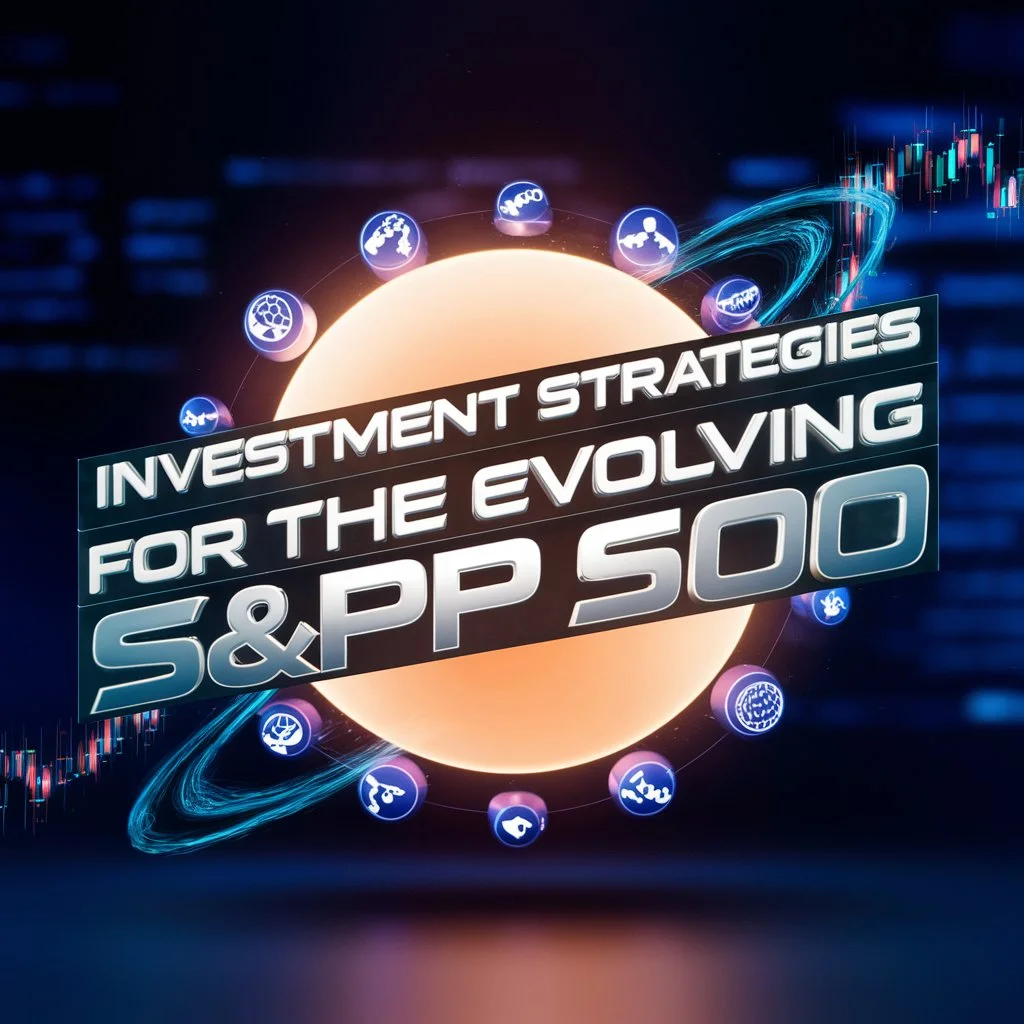The S&P 500, a cornerstone of the global financial market, stands at the cusp of a transformative era driven by fintech innovations. As we delve into the Fintechzoom SP500 news, a game-changing outlook for the future emerges, reshaping how we perceive and interact with this benchmark index. The convergence of technology and finance is not just altering the composition of the S&P 500 but also redefining its role in the investment landscape.
Key factors influencing the S&P 500’s future:
- Rapid integration of AI and blockchain technologies
- Growing emphasis on ESG criteria in stock selection
- Democratization of investing through fintech platforms
The S&P 500’s journey from a simple stock market index to a dynamic reflection of technological progress exemplifies the broader shifts in the global economy. As fintech companies gain prominence and traditional sectors undergo digital transformations, the very DNA of the S&P 500 is evolving. This article explores the multifaceted impact of fintech on the S&P 500, offering insights into emerging trends, potential risks, and strategies for navigating this new financial frontier.
The Current State of the S&P 500
The S&P 500 index, a key barometer of US economic health, continues to show resilience and growth. Recent performance trends reveal a market adapting to rapid technological changes and global economic shifts. Let’s break down the current state of this crucial index.
Performance and Trends:
- Steady growth despite market volatility
- Tech sector dominance in index weighting
- Increased influence of fintech companies
The S&P 500 has seen strong returns in recent years, outpacing many other global indices. This growth is largely driven by the tech sector, which now makes up a significant portion of the index. Companies like Apple, Microsoft, and Amazon have become major players, reflecting the digital transformation of the economy.
Fintech’s rising influence is clear in the index composition. PayPal and Square (now Block) are prime examples of fintech firms that have joined the S&P 500. Their inclusion signals a shift towards digital financial services and showcases the growing importance of innovative payment solutions.
Key Sectors Driving Growth:
- Information Technology
- Healthcare
- Consumer Discretionary
- Communication Services
- Financials
The tech sector’s dominance is clear, but other sectors are also adapting to fintech trends. Healthcare companies are leveraging big data and AI for drug discovery and patient care. Retailers in the Consumer Discretionary sector are embracing e-commerce and digital payments. Even traditional banks are investing heavily in digital transformation to stay competitive.
Comparison with Other Indices: The S&P 500’s performance often outshines other major indices like the Dow Jones Industrial Average or the NASDAQ Composite. Its broader representation of the US economy and inclusion of mid-cap stocks alongside large-caps contribute to this edge. However, the NASDAQ, with its tech-heavy composition, sometimes surges ahead during periods of intense tech sector growth.
Challenges and Concerns: While the outlook is generally positive, some analysts express concerns:
- Potential overvaluation of tech stocks
- Cybersecurity risks for digital-first companies
- Regulatory challenges for big tech and fintech firms
These factors could impact the index’s future performance and composition. The increasing weight of tech stocks in the index also raises questions about diversification and sector balance.
ESG Considerations: Environmental, Social, and Governance (ESG) criteria are gaining importance in index composition. Many S&P 500 companies are adapting their practices to meet ESG standards, potentially influencing future stock selections and weightings within the index.
Looking Ahead: As we analyze Fintechzoom SP500 news, it’s clear that the index is at a pivotal point. The integration of fintech, the rise of ESG investing, and the ongoing digital transformation across sectors are shaping its future. Investors and analysts alike are watching closely to see how these trends will play out in the coming years.
The S&P 500’s current state reflects a market in transition. It balances traditional economic powerhouses with emerging fintech leaders, creating a dynamic and forward-looking index. As we move forward, understanding these shifts will be key to grasping the full picture of the US and global economy.
Fintech’s Growing Influence on the S&P 500

The rise of financial technology, or fintech, is reshaping the S&P 500 in profound ways. This sector’s impact goes beyond just adding new companies to the index. It’s changing how existing companies operate and compete.
What is Fintech? Fintech refers to new tech that aims to improve and automate financial services. It covers a wide range of applications:
- Mobile banking
- Cryptocurrency and blockchain
- Robo-advisors
- Peer-to-peer lending platforms
- Digital payment systems
These innovations are not just creating new companies. They’re forcing traditional firms to adapt or risk becoming obsolete.
Fintech Companies in the S&P 500: Several fintech firms have already made their mark on the index:
- PayPal (PYPL): A leader in digital payments
- Square (now Block) (SQ): Offers point-of-sale systems and cryptocurrency services
- Intuit (INTU): Provides financial software for individuals and small businesses
- Fiserv (FISV): Delivers financial services technology to banks and merchants
These companies represent the first wave of fintech inclusion in the S&P 500. Their strong performance has paved the way for more fintech firms to join the index in the future.
Potential Future Additions: As the fintech sector grows, several companies are positioned to potentially join the S&P 500:
- Stripe: A major player in online payment processing
- Robinhood: A popular commission-free trading platform
- Coinbase: A leading cryptocurrency exchange
The inclusion of these companies would further increase fintech’s weight in the index. It would also reflect the growing importance of digital currencies and democratized investing.
Impact on Traditional Sectors: Fintech isn’t just adding new companies to the S&P 500. It’s changing how existing index members operate:
- Banks are investing heavily in digital services
- Retailers are adopting new payment technologies
- Insurance companies are using AI for risk assessment
This shift is blurring the lines between tech and finance. It’s also forcing us to rethink traditional sector classifications within the index.
Challenges and Opportunities: The growth of fintech in the S&P 500 brings both risks and rewards:
Challenges:
- Increased cybersecurity risks
- Regulatory uncertainties
- Potential for market volatility
Opportunities:
- Enhanced financial inclusion
- Improved efficiency in financial services
- New avenues for economic growth
Investors and index managers must navigate these factors carefully. The companies that successfully manage these challenges could become the index leaders of tomorrow.
Long-term Outlook: As we look to the future, fintech’s influence on the S&P 500 is likely to grow. We may see:
- More fintech-focused ETFs tracking parts of the index
- Changes in how sectors are weighted within the S&P 500
- A shift in how we define “blue chip” stocks
The integration of fintech into the S&P 500 reflects broader changes in the economy. It shows how technology is reshaping every aspect of finance and business.
For investors, understanding these trends is crucial. The S&P 500 of the future may look very different from today’s index. Those who grasp the impact of fintech will be better positioned to navigate these changes.
As fintech continues to evolve, its influence on the S&P 500 will be a key trend to watch. It’s not just changing the index – it’s changing the very nature of how we interact with money and investments.
Technological Disruptions Affecting S&P 500 Companies
The S&P 500 is undergoing a technological revolution. Companies across all sectors are adopting new technologies to stay competitive. These changes are reshaping the index and the market as a whole.
AI and Machine Learning in Financial Services: Artificial Intelligence (AI) and Machine Learning (ML) are transforming how S&P 500 companies operate:
- Banks use AI for fraud detection and credit scoring
- Investment firms employ ML for market predictions
- Insurance companies leverage AI for risk assessment
Companies like JPMorgan Chase and Goldman Sachs are investing heavily in AI. They aim to improve efficiency and decision-making. This trend is likely to accelerate, potentially reshaping the financial sector within the S&P 500.
Blockchain and Cryptocurrency Adoption: Blockchain technology and cryptocurrencies are gaining traction among S&P 500 companies:
- Square (now Block) has invested in Bitcoin
- PayPal allows cryptocurrency transactions
- IBM offers blockchain solutions to other businesses
While cryptocurrencies remain volatile, blockchain technology has wider applications. It’s being used for supply chain management, data security, and more. As adoption grows, it could impact how we value companies in the index.
Big Data and Analytics: Big data is becoming crucial for S&P 500 companies across sectors:
- Retailers use data to personalize marketing
- Healthcare firms analyze patient data to improve outcomes
- Manufacturers optimize operations with data-driven insights
Companies like Amazon and Walmart are leaders in using big data. Their success is changing expectations for all S&P 500 companies. The ability to collect and use data effectively may become a key factor in index performance.
Cloud Computing’s Impact on Scalability: Cloud computing is changing how S&P 500 companies operate and grow:
- It allows for rapid scaling of operations
- Reduces the need for physical infrastructure
- Enables more flexible and remote work models
Tech giants like Microsoft, Amazon, and Google are major cloud providers. But companies in all sectors are adopting cloud solutions. This shift is making businesses more agile and potentially more profitable.
Internet of Things (IoT) and Connectivity: The Internet of Things is creating new opportunities for S&P 500 companies:
- Industrial firms use IoT for predictive maintenance
- Healthcare companies employ connected devices for patient monitoring
- Utility companies leverage smart grids for efficient energy distribution
Companies like General Electric and Johnson & Johnson are integrating IoT into their products and operations. This trend is blurring the lines between tech and non-tech companies in the index.
Cybersecurity Challenges: As technology adoption grows, so do cybersecurity risks:
- Financial firms invest heavily in security to protect customer data
- Retailers strengthen defenses against payment fraud
- Healthcare companies work to secure patient information
Cybersecurity firms like Palo Alto Networks are gaining prominence. Their services are becoming essential for all S&P 500 companies. This could lead to growth in the cybersecurity sector within the index.
Impact on Index Composition: These technological disruptions are changing the makeup of the S&P 500:
- Tech companies are growing larger and more influential
- Traditional companies are becoming more tech-focused
- New tech-driven companies are entering the index
The result is a more technology-centric S&P 500. This shift reflects broader changes in the economy and society.
Looking Ahead: As technology continues to evolve, its impact on the S&P 500 will grow. Investors should watch for:
- Emerging technologies that could disrupt current leaders
- Traditional companies successfully adopting new tech
- Potential regulatory changes in response to tech adoption
Understanding these technological disruptions is key to grasping the future of the S&P 500. They’re not just changing individual companies – they’re reshaping the entire economic landscape.
Changing Dynamics of Traditional Sectors

The S&P 500 isn’t just about tech companies. Traditional sectors are changing too. They’re adopting new technologies and business models. This shift is reshaping the entire index.
Banking and Financial Services Transformation: Banks and financial firms are embracing fintech:
- Mobile banking apps are now standard
- Robo-advisors offer automated investment services
- Blockchain is being tested for faster, cheaper transactions
Big banks like JPMorgan Chase and Bank of America are investing billions in tech. They’re competing with fintech startups and tech giants. This race is blurring the lines between finance and technology.
Some changes we’re seeing:
- Branches are closing as online banking grows
- AI is being used for customer service and fraud detection
- Partnerships with tech firms are becoming common
These shifts could change how we value financial stocks in the S&P 500.
Retail Sector’s E-commerce Revolution: Retail is undergoing a massive change:
- Online shopping is growing fast
- Physical stores are becoming showrooms and pickup points
- AI is being used for inventory management and personalized marketing
Amazon’s success has forced other retailers to adapt. Walmart, Target, and others are investing heavily in e-commerce. They’re also using data analytics to understand customers better.
Key trends:
- Mobile shopping is on the rise
- Social media is becoming a sales channel
- Same-day delivery is becoming more common
These changes are affecting how retail stocks perform in the S&P 500.
Healthcare’s Tech-Driven Innovations: The healthcare sector is embracing technology:
- Telemedicine is growing, especially after COVID-19
- AI is being used for drug discovery and diagnosis
- Wearable devices are collecting health data
Companies like UnitedHealth and Johnson & Johnson are investing in digital health. They’re working to improve patient care and reduce costs.
Notable developments:
- Electronic health records are becoming standard
- Precision medicine is tailoring treatments to individuals
- Robotics is improving surgery outcomes
These innovations could lead to big changes in healthcare stocks’ performance.
Energy Sector’s Shift Towards Renewables and Smart Grids: The energy sector is going through a major transition:
- Renewable energy is growing fast
- Smart grids are making power distribution more efficient
- Electric vehicles are changing the demand for oil
Traditional energy companies like ExxonMobil are investing in clean energy. At the same time, new players like Tesla are entering the S&P 500.
Key shifts:
- Solar and wind power costs are falling
- Battery technology is improving
- Carbon capture is gaining attention
These changes could reshape the energy sector’s role in the S&P 500.
Industrial Sector’s Move to Industry 4.0: The industrial sector is embracing the Fourth Industrial Revolution:
- IoT sensors are improving equipment maintenance
- 3D printing is changing manufacturing processes
- AI is optimizing supply chains
Companies like General Electric and Honeywell are leading this change. They’re becoming as much about software as hardware.
Important trends:
- Predictive maintenance is reducing downtime
- Digital twins are improving product design
- Augmented reality is enhancing worker training
These shifts are changing how we view industrial stocks in the index.
Looking Ahead: As traditional sectors evolve, the S&P 500 is changing too. We might see:
- New sector classifications emerging
- Changes in how sectors are weighted in the index
- Traditional companies becoming more like tech firms
For investors, understanding these shifts is crucial. The S&P 500 of tomorrow may look very different from today’s index. But it will still reflect the changing face of the American economy.
The Rise of ESG Factors
Environmental, Social, and Governance (ESG) factors are reshaping the S&P 500. These criteria are changing how companies operate and how investors value them. This shift is having a big impact on the index’s composition and performance.
What are ESG Factors?
- Environmental: How a company impacts nature
- Social: How a company treats people and communities
- Governance: How a company is run and managed
ESG is not just about being good. It’s about managing risks and finding new opportunities. Companies with strong ESG practices often perform better in the long run.
Growing Importance of ESG:
Investors are paying more attention to ESG:
- Many now consider ESG when making investment decisions
- Some are pushing companies to improve their ESG practices
- ESG-focused funds are growing in popularity
This trend is affecting how S&P 500 companies operate. Many are improving their ESG practices to attract investors and avoid risks.
How ESG is Reshaping the S&P 500:
ESG is changing the index in several ways:
- Company Behavior: • More companies are setting climate goals • Diversity and inclusion are becoming priorities • Transparency in governance is increasing
- Index Composition: • Companies with strong ESG practices may see their stock prices rise • Those lagging in ESG might face investor pressure or even exclusion from the index • New ESG leaders might join the S&P 500
- Sector Dynamics: • Clean energy companies are gaining prominence • Tech firms are being scrutinized for data privacy and worker treatment • Financial companies are facing pressure to consider climate risks
ESG Performance in the S&P 500:
Studies show that companies with high ESG scores often perform well:
- They may be better at managing risks
- They often attract more investor interest
- They might be more innovative and adaptable
However, the relationship between ESG and financial performance is complex. It can vary by sector and over time.
Potential Future Weighting Adjustments:
As ESG becomes more important, we might see changes in how the S&P 500 is weighted:
- ESG factors could influence a company’s weight in the index
- New ESG-focused versions of the S&P 500 might emerge
- Sector weightings could shift based on overall ESG performance
Challenges and Debates:
The rise of ESG is not without controversy:
- There’s debate over how to measure ESG factors
- Some worry about “greenwashing” – companies overstating their ESG efforts
- There are questions about the impact on returns and diversification
Despite these challenges, ESG continues to gain traction.
Impact on Investor Strategies:
The rise of ESG is changing how people invest in the S&P 500:
- Some are using ESG scores to pick individual stocks
- Others are choosing ESG-focused index funds
- Many are engaging with companies to improve their ESG practices
This shift could change trading patterns and affect stock prices within the index.
Looking Ahead:
As ESG factors become more important, we can expect:
- More detailed ESG reporting from S&P 500 companies
- Potential changes in index methodology to reflect ESG
- Growing influence of ESG on stock performance and index composition
For investors, understanding ESG trends is becoming crucial. It’s not just about ethics – it’s about understanding the full range of risks and opportunities in the market.
The rise of ESG is more than a trend. It’s a fundamental shift in how we view and value companies. As it continues to shape the S&P 500, it will play a key role in defining the future of investing.
Democratization of Investing

The way people invest in the S&P 500 is changing. New tools and platforms are making it easier for everyone to invest. This shift is having a big impact on the market and the index itself.
Impact of Commission-Free Trading Platforms:
Commission-free trading has changed the game:
- Platforms like Robinhood and WeBull offer free trades
- This has made it cheaper to buy and sell stocks
- More people can now invest in S&P 500 companies
These platforms have brought in many new, young investors. They’re changing trading patterns and maybe even stock valuations.
Key effects:
- Increased trading volume for some stocks
- More volatility in certain sectors
- Growing interest in popular S&P 500 companies
This trend is making the S&P 500 more accessible to everyday investors.
Fractional Shares and Increased Accessibility:
Fractional shares are another big change:
- Investors can buy parts of expensive stocks
- This makes it easier to invest in high-priced S&P 500 companies
- It allows for more diversified portfolios with less money
Companies like Amazon and Alphabet, with high share prices, are now within reach for more investors.
Benefits of fractional shares:
- More people can invest in the entire S&P 500
- Easier to maintain specific portfolio allocations
- Allows for dollar-cost averaging with any amount
This innovation is bringing more investors into the S&P 500 market.
Robo-Advisors and Automated Investing Strategies:
Robo-advisors are changing how people invest:
- They offer automated, algorithm-based portfolio management
- Many focus on low-cost ETFs that track the S&P 500
- They make professional-style investing available to everyone
Companies like Betterment and Wealthfront are growing fast. They’re bringing new investors to the S&P 500.
Features of robo-advisors:
- Automatic rebalancing
- Tax-loss harvesting
- Low fees compared to traditional advisors
These tools are making S&P 500 investing more accessible and efficient.
Social Trading and Investment Communities:
Social media is influencing S&P 500 investing:
- Platforms like Reddit’s WallStreetBets discuss S&P 500 stocks
- Social trading apps let users copy other investors’ trades
- Twitter and TikTok are becoming sources of investment ideas
This trend is creating new dynamics in how S&P 500 stocks are traded and valued.
Effects of social trading:
- Can lead to sudden surges in certain stocks
- Brings attention to companies that might be overlooked
- Sometimes creates conflicts with traditional investment wisdom
While exciting, this trend also brings new risks to the market.
Impact on Market Dynamics:
These changes are affecting how the S&P 500 behaves:
- More retail investor participation
- Potentially faster reactions to news and events
- New patterns in stock popularity and trading volume
Some worry these trends could lead to market bubbles or crashes. Others see them as a natural evolution of the market.
Challenges and Opportunities:
The democratization of investing brings both risks and rewards:
Challenges:
- Potential for inexperienced investors to take big risks
- Concerns about gamification of investing
- Questions about market stability with more retail traders
Opportunities:
- More people building wealth through the stock market
- Increased liquidity in S&P 500 stocks
- Potential for more diverse shareholder bases
Regulators and market experts are watching these trends closely.
Looking Ahead:
As investing becomes more democratic, we might see:
- Changes in how S&P 500 companies communicate with investors
- New types of index funds and ETFs aimed at retail investors
- Evolving regulations to protect novice investors
The democratization of investing is changing the relationship between the S&P 500 and the general public. It’s making the index more than just a market measure – it’s turning it into a widely accessible investment tool.
Global Economic Factors Influencing the S&P 500
The S&P 500 doesn’t exist in a vacuum. Global events and trends shape its performance. Understanding these factors is key for investors and analysts alike.
Trade Policies and International Relations:
Trade policies have a big impact on the S&P 500:
- Tariffs can affect company profits
- Trade agreements open new markets
- Political tensions can create uncertainty
Recent years have seen trade disputes between the US and China. These affected many S&P 500 companies, especially in tech and manufacturing.
Key effects:
- Supply chain disruptions
- Changes in consumer prices
- Shifts in global market share
Investors watch trade news closely, as it can quickly move S&P 500 stocks.
Currency Fluctuations and Their Effects:
Exchange rates matter for S&P 500 companies:
- A strong dollar can hurt exports but make imports cheaper
- A weak dollar can boost overseas profits when converted to USD
- Currency hedging is important for multinational firms
Companies like Apple and Coca-Cola are very sensitive to currency changes. Their global sales mean exchange rates directly affect their bottom line.
Important points:
- Currency trends can shift sector performance
- Some companies benefit from a strong dollar, others from a weak one
- Sudden currency moves can lead to earnings surprises
Currency effects can be complex, often affecting S&P 500 companies in different ways.
Emerging Markets and Their Growing Influence:
Emerging markets are increasingly important:
- They offer growth opportunities for S&P 500 companies
- Their economic health affects global demand
- Emerging market companies may compete with S&P 500 firms
Countries like India, Brazil, and Indonesia are key markets for many S&P 500 companies.
Trends to watch:
- Rising middle class in emerging markets
- Technological leapfrogging in some sectors
- Political and economic reforms
The fortunes of emerging markets can significantly impact S&P 500 performance.
Global Interest Rates and Monetary Policy:
Central bank decisions worldwide affect the S&P 500:
- Low interest rates often boost stock prices
- Rate hikes can slow economic growth
- Quantitative easing policies impact market liquidity
The Federal Reserve’s decisions are crucial, but policies of the European Central Bank, Bank of Japan, and others matter too.
Key considerations:
- Interest rates affect borrowing costs for companies
- They influence investor preferences between stocks and bonds
- Global rate differentials can drive currency movements
Investors closely watch central bank meetings for clues about future policy.
Global Events and Crises:
Major world events can shake the S&P 500:
- Natural disasters disrupt supply chains
- Geopolitical crises create market uncertainty
- Global health issues like pandemics affect consumer behavior
The COVID-19 pandemic showed how a global crisis can rapidly impact the entire index.
Types of events to monitor:
- Political changes in major economies
- Energy price shocks
- Technological breakthroughs
These events can cause both short-term volatility and long-term shifts in the S&P 500.
Climate Change and Environmental Factors:
Environmental issues are increasingly affecting the S&P 500:
- Extreme weather events can disrupt operations
- Changing regulations impact certain sectors
- New opportunities arise in green technology
Companies across the index are adapting to climate-related risks and opportunities.
Areas of impact:
- Energy sector transformation
- Agriculture and food production changes
- Insurance industry challenges
Climate considerations are becoming central to long-term business strategies.
Looking Ahead:
As the world becomes more interconnected, global factors will likely play an even bigger role in S&P 500 performance. Investors may need to:
- Monitor a wider range of global indicators
- Understand complex international relationships
- Be prepared for faster market reactions to global events
The S&P 500 remains a US index, but its future is increasingly tied to global economic trends.
Regulatory Landscape and Its Impact

Regulations play a big role in shaping the S&P 500. They affect how companies operate and compete. As the business world changes, so do the rules that govern it.
Current and Proposed Fintech Regulations:
Fintech is a hot area for regulators:
- Cryptocurrency rules are evolving
- Digital banking regulations are being updated
- Payment processing laws are changing
These rules affect both new fintech firms and traditional S&P 500 companies.
Key regulatory areas:
- Consumer protection in digital finance
- Anti-money laundering for crypto
- Open banking initiatives
Companies like PayPal and Square are watching these developments closely.
Data Privacy Concerns and Their Implications:
Data privacy is a growing issue:
- GDPR in Europe set new global standards
- California’s CCPA is influencing US practices
- More states and countries are passing privacy laws
Tech giants in the S&P 500 are especially affected by these rules.
Important points:
- Stricter data collection and use policies
- Higher costs for compliance
- Potential fines for violations
Companies must balance data use for business with privacy protection.
Antitrust Scrutiny of Big Tech Companies:
Big tech faces increasing antitrust pressure:
- Concerns about market dominance
- Investigations into anti-competitive practices
- Debates about breaking up large tech firms
This affects major S&P 500 companies like Apple, Amazon, and Google.
Potential outcomes:
- Forced divestitures
- Limits on acquisitions
- Changes to platform rules
These issues could reshape the tech sector within the S&P 500.
Environmental Regulations:
Climate change is driving new rules:
- Emissions reporting requirements
- Clean energy incentives
- Carbon pricing schemes
These affect many sectors, from energy to manufacturing to transportation.
Areas of impact:
- Increased costs for high-emission industries
- New opportunities in green tech
- Changes in energy mix for utilities
Companies are adapting strategies to comply and stay competitive.
Financial Sector Regulations:
Banks and financial firms face ongoing regulatory changes:
- Capital requirements evolve
- Stress testing becomes more complex
- New rules target systemic risk
These affect a significant portion of the S&P 500.
Key trends:
- Push for more transparency
- Focus on consumer protection
- Efforts to prevent another financial crisis
Financial firms must navigate these rules while staying profitable.
Healthcare and Pharmaceutical Regulations:
The healthcare sector sees frequent regulatory changes:
- Drug pricing debates continue
- Telehealth rules are evolving
- Data privacy in healthcare is a focus
These impact major S&P 500 healthcare and pharma companies.
Important areas:
- Clinical trial regulations
- Insurance market rules
- Medical device approvals
Regulatory changes can quickly affect stock prices in this sector.
Cross-Border Regulations:
Global companies face a complex regulatory landscape:
- Trade regulations vary by country
- Tax rules for multinational firms are changing
- Labor laws differ across borders
Many S&P 500 companies must navigate these international rules.
Challenges include:
- Complying with conflicting regulations
- Adapting to sudden rule changes
- Managing global regulatory risk
This complexity can impact company operations and profits.
Looking Ahead:
The regulatory landscape is always changing. In the future, we might see:
- More global coordination on tech and finance rules
- Increased focus on ESG-related regulations
- New rules for emerging technologies like AI
For S&P 500 companies, staying ahead of regulatory trends is crucial. It’s not just about compliance – it’s about finding opportunities in a changing landscape.
Investors should watch regulatory developments closely. They can signal upcoming challenges or opportunities for S&P 500 companies.
Predictions for the Future of the S&P 500
As we look ahead, the S&P 500 is likely to evolve in significant ways. These changes will reflect broader shifts in technology, the economy, and society. Here are some key predictions for the future of this important index.
Potential Sector Rebalancing:
The makeup of the S&P 500 is likely to change:
- Tech sector may continue to grow in importance
- New sectors might emerge or gain prominence
- Traditional sectors could shrink or transform
We might see:
- A larger allocation to tech and tech-adjacent companies
- Growth in sectors like renewable energy and biotech
- Shrinking representation from fossil fuel companies
This rebalancing could change how the index performs and how investors approach it.
Emergence of New Industries and Categories:
New industries could join or reshape the S&P 500:
- Space technology companies might become more prominent
- Artificial intelligence firms could form their own category
- Sustainable technology might become a distinct sector
Potential new areas:
- Quantum computing
- Advanced robotics
- Personalized medicine
These emerging fields could bring new growth drivers to the index.
Long-term Growth Projections:
Experts have varying views on long-term S&P 500 growth:
- Some predict continued strong returns
- Others warn of slower growth due to market saturation
- Many see increased volatility as likely
Factors influencing projections:
- Global economic trends
- Technological disruption
- Demographic shifts
Investors should prepare for a range of possible outcomes.
Impact of Artificial Intelligence:
AI could transform many S&P 500 companies:
- It might boost productivity across sectors
- Some jobs could be automated, changing workforce needs
- New AI-focused companies might join the index
Potential effects:
- Increased efficiency and profits for AI adopters
- Disruption in industries slow to adapt
- New ethical and regulatory challenges
AI could become a key factor in company valuations.
Globalization vs. Localization Trends:
The balance between global and local focus may shift:
- Some companies might focus more on domestic markets
- Others could become even more globally integrated
- Trade policies and geopolitics will play a role
Possible outcomes:
- More diverse geographic revenue sources
- Increased importance of emerging markets
- New challenges in managing global operations
This could affect how S&P 500 companies operate and grow.
ESG Integration:
Environmental, Social, and Governance factors may become central:
- ESG performance could influence index inclusion
- Sustainability might drive innovation and growth
- Social responsibility could impact consumer choices
We might see:
- More companies setting science-based climate targets
- Increased focus on diversity and inclusion
- Greater transparency in corporate governance
ESG could become a key driver of long-term value.
Technological Convergence:
Different technologies might combine in new ways:
- IoT, AI, and blockchain could integrate
- Biotech and nanotech might merge
- Virtual and augmented reality could blend with other fields
This could lead to:
- New types of products and services
- Innovative business models
- Unexpected market leaders emerging
Companies that navigate this convergence well could become S&P 500 stars.
Challenges and Uncertainties:
The future also holds potential challenges:
- Cybersecurity threats could increase
- Geopolitical tensions might affect global business
- Climate change could disrupt various industries
Companies will need to:
- Adapt quickly to changing conditions
- Manage new types of risks
- Stay ahead of regulatory changes
How well S&P 500 companies handle these challenges could determine the index’s future performance.
Looking Ahead:
The S&P 500 of the future may look quite different from today’s index. Investors and analysts should:
- Stay informed about emerging trends
- Be prepared for new types of market leaders
- Consider a long-term, adaptable investment approach
The index will continue to reflect the changing face of the American and global economy, offering both opportunities and challenges for investors.
Investment Strategies for the Evolving S&P 500

As the S&P 500 changes, investment strategies must adapt. Here are some approaches investors might consider in this evolving landscape.
Balancing Traditional and Fintech-Focused Investments:
The rise of fintech is changing the game:
- Consider a mix of established financial firms and fintech innovators
- Look for traditional companies successfully adopting fintech
- Watch for fintech firms poised to join the S&P 500
Potential strategy:
- Allocate a portion of investments to fintech-focused ETFs
- Invest in banks that are leaders in digital transformation
- Keep an eye on upcoming fintech IPOs
This balanced approach can capture growth while managing risk.
Considering Thematic ETFs and Sector-Specific Strategies:
Thematic investing is gaining popularity:
- ETFs focused on AI, robotics, or clean energy offer targeted exposure
- Sector-specific funds allow bets on particular areas of the economy
- Thematic strategies can complement broad S&P 500 investments
Examples:
- Cybersecurity ETFs for exposure to digital defense firms
- Genomics funds to tap into biotech innovations
- Electric vehicle ETFs to ride the green transport wave
These focused investments can add growth potential to a portfolio.
The Role of Active vs. Passive Management:
The active vs. passive debate continues:
- Passive S&P 500 index funds offer low-cost, broad market exposure
- Active managers aim to outperform by selecting promising stocks
- A combination of both approaches might be beneficial
Considerations:
- Passive investing has generally been more cost-effective
- Active management might help navigate rapid market changes
- Factor investing offers a middle ground between active and passive
Investors should consider their goals and risk tolerance when choosing.
Incorporating ESG Criteria:
ESG investing is becoming mainstream:
- Look for S&P 500 companies with strong ESG profiles
- Consider ESG-focused versions of S&P 500 index funds
- Use ESG ratings as part of the stock selection process
Potential approaches:
- Invest in sustainability leaders within each sector
- Use ESG-weighted S&P 500 ETFs
- Engage with companies to improve their ESG practices
ESG integration can align investments with values and manage long-term risks.
Leveraging Technology for Investment Decisions:
New tools are changing how people invest:
- Robo-advisors offer automated S&P 500 investing
- AI-powered analytics can help identify trends
- Social sentiment analysis might provide new insights
Ways to use tech:
- Use robo-advisors for low-cost, diversified S&P 500 exposure
- Employ AI tools to screen for promising S&P 500 stocks
- Monitor social media trends for potential market movers
Technology can help make more informed investment choices.
Global Diversification Strategies:
While focused on U.S. stocks, the S&P 500 has global reach:
- Many S&P 500 companies have significant international exposure
- Consider complementing S&P 500 investments with international funds
- Look for S&P 500 firms benefiting from global growth trends
Approaches:
- Invest in S&P 500 companies with strong global presence
- Add emerging market ETFs to capture growth beyond the S&P 500
- Consider global sector funds that include S&P 500 stocks
Global diversification can help manage risk and capture worldwide opportunities.
Adapting to Market Volatility:
Volatility may increase in the evolving market:
- Consider dollar-cost averaging into S&P 500 investments
- Use options strategies for downside protection
- Maintain a long-term perspective despite short-term fluctuations
Strategies:
- Set up automatic monthly investments in S&P 500 index funds
- Use covered call writing on S&P 500 stocks for income
- Keep some cash reserves for buying opportunities during dips
A thoughtful approach to volatility can turn challenges into opportunities.
Looking Ahead:
As the S&P 500 evolves, successful investing will require:
- Staying informed about market trends and company developments
- Being flexible and willing to adapt strategies
- Balancing long-term goals with short-term market movements
Remember, diversification and a clear understanding of your risk tolerance remain key principles in navigating the changing S&P 500 landscape.
Risks and Challenges
As the S&P 500 evolves, it faces various risks and challenges. Investors and companies must navigate these carefully. Understanding these issues is key to making informed decisions.
Cybersecurity Threats and Their Potential Impact:
Cyber risks are growing for S&P 500 companies:
- Data breaches can damage reputation and finances
- Ransomware attacks can disrupt operations
- Intellectual property theft threatens competitive advantage
Key concerns:
- Financial services firms are prime targets
- Tech companies must protect vast amounts of user data
- Industrial firms face risks to their operational technology
A major cyber attack could significantly impact stock prices and index performance.
Market Volatility Due to Rapid Technological Changes:
Fast tech changes can lead to market swings:
- Disruptive innovations may threaten established companies
- Rapid adoption of new technologies can create bubbles
- Tech-driven market corrections could become more common
Potential effects:
- Increased short-term price fluctuations
- Faster sector rotations within the index
- Challenges in valuing companies with new business models
Investors may need to adapt to a more volatile S&P 500 environment.
Overvaluation Concerns in the Tech Sector:
Some worry the tech sector is overvalued:
- High P/E ratios in some tech stocks raise concerns
- The sector’s large weight in the index could amplify risks
- A tech bubble burst could significantly impact the entire S&P 500
Points to consider:
- Historical comparisons with past bubbles
- The role of intangible assets in company valuations
- The sustainability of high growth rates
A tech sector correction could have widespread effects on the index.
Regulatory Risks and Compliance Challenges:
Changing regulations pose ongoing challenges:
- Antitrust actions could impact big tech companies
- New data privacy laws may increase compliance costs
- Environmental regulations could affect multiple sectors
Areas to watch:
- Financial regulations in response to fintech growth
- Healthcare policy changes affecting pharma and insurance
- Tech regulation aimed at social media and e-commerce giants
Regulatory changes can quickly alter the competitive landscape.
Geopolitical Tensions and Trade Disputes:
Global issues can affect S&P 500 companies:
- Trade wars can disrupt supply chains and markets
- Political instability can impact global operations
- Currency fluctuations can affect international profits
Potential impacts:
- Reduced access to key markets or resources
- Increased costs due to tariffs or sanctions
- Uncertainty affecting long-term business planning
Companies with global exposure may face heightened risks.
Climate Change and Environmental Risks:
Environmental factors pose long-term challenges:
- Extreme weather events can disrupt operations
- Transition to low-carbon economy may strand assets
- Changing consumer preferences for sustainable products
Key considerations:
- Physical risks to facilities and supply chains
- Transition risks as economies decarbonize
- Reputation risks for companies seen as environmental laggards
Climate-related risks could reshape entire sectors within the S&P 500.
Demographic Shifts and Changing Consumer Behavior:
Societal changes bring both risks and opportunities:
- Aging populations in key markets affect demand patterns
- Millennial and Gen Z preferences reshape industries
- Urbanization trends impact real estate and retail sectors
Areas of change:
- Healthcare and financial services adapting to older customers
- Retail and media evolving for digital-native consumers
- Housing and transportation adjusting to new urban realities
Companies that fail to adapt to demographic shifts may struggle.
Looking Ahead:
Managing these risks and challenges will be crucial for S&P 500 companies and investors:
- Diversification remains important to spread risk
- Active risk management may become more critical
- Long-term thinking can help navigate short-term volatility
While risks are significant, they also bring opportunities for innovative companies and informed investors.
Expert Opinions and Analysis
To better understand the future of the S&P 500, let’s look at what experts are saying. Their insights can help guide investment decisions and business strategies.
Insights from Leading Financial Analysts:
Top analysts offer varied views on the S&P 500’s future:
- Some predict continued growth driven by tech and innovation
- Others warn of potential market corrections
- Many emphasize the importance of adaptability in investing
Key points from analysts:
- The role of AI in reshaping index companies
- Potential for new sectors to gain prominence
- Impact of global economic shifts on S&P 500 performance
These expert views can help investors form their own strategies.
Economist Perspectives on Long-term Trends:
Economists focus on broader trends affecting the S&P 500:
- Changing global trade patterns
- Shifts in consumer behavior post-pandemic
- Long-term effects of monetary and fiscal policies
Important economic factors:
- Inflation expectations and their impact on stocks
- Productivity gains from technological adoption
- Demographic shifts in major markets
Economic trends provide context for S&P 500 performance.
Contrasting Viewpoints on the Future of the Index:
Experts often disagree on what’s next for the S&P 500:
- Bulls see continued innovation driving growth
- Bears worry about overvaluation and potential bubbles
- Some predict major composition changes in the index
Areas of debate:
- Sustainability of tech sector dominance
- Potential for traditional sectors to rebound
- Impact of ESG factors on index performance
These diverse views highlight the complexity of predicting market trends.
Technology Experts on Digital Transformation:
Tech specialists offer insights on how digital changes will affect the S&P 500:
- Adoption of AI and machine learning across sectors
- Blockchain’s potential to reshape financial services
- Impact of 5G and IoT on various industries
Key predictions:
- Increased automation in manufacturing and services
- Growth of platform-based business models
- Cybersecurity becoming central to company valuations
Tech trends could reshape many S&P 500 companies.
ESG Analysts on Sustainable Investing:
ESG experts see growing importance of sustainability:
- Climate risk becoming a key factor in company valuations
- Social factors influencing consumer and investor choices
- Governance issues gaining attention post-corporate scandals
Trends in ESG:
- Growth of impact investing within the S&P 500
- Increased corporate focus on sustainability goals
- Potential for ESG leaders to outperform in the long run
ESG considerations may increasingly drive S&P 500 performance.
Regulatory Experts on Upcoming Changes:
Those tracking regulations foresee significant shifts:
- Potential for increased tech sector regulation
- Changes in financial rules post-fintech boom
- Environmental regulations affecting multiple sectors
Areas to watch:
- Antitrust actions against big tech
- Data privacy laws impacting digital business models
- Climate-related disclosure requirements
Regulatory changes could reshape the competitive landscape.
Industry-Specific Insights:
Experts in various fields offer sector-specific views:
- Healthcare: Focus on digital health and personalized medicine
- Energy: Transition to renewables and smart grid technologies
- Retail: Continued shift to e-commerce and experiential shopping
Sector trends:
- Financial services embracing AI and blockchain
- Industrials adopting IoT and advanced robotics
- Media evolving with streaming and virtual reality
These insights can guide sector-specific investment strategies.
Synthesizing Expert Views:
While experts often disagree, some common themes emerge:
- Technology will continue to drive significant changes
- Adaptability is key for companies and investors
- Global and societal trends will shape the index’s future
Investors should:
- Consider multiple expert perspectives
- Stay informed about evolving trends
- Develop flexible strategies to navigate changes
Expert insights, combined with personal research, can inform better decision-making in the evolving S&P 500 landscape.

I’m Justin Taylor, your go-to guy at “San Antonio Vista.” I’ve been soaking in the colors and stories of this city for a while now, and I want you to join me on this fantastic journey. At San Antonio Vista, we’re all about making your visit unforgettable. It’s not just tourism; it’s like turning information into a real, vibrant experience. Come along, and let’s explore the wonders of San Antonio together!
















